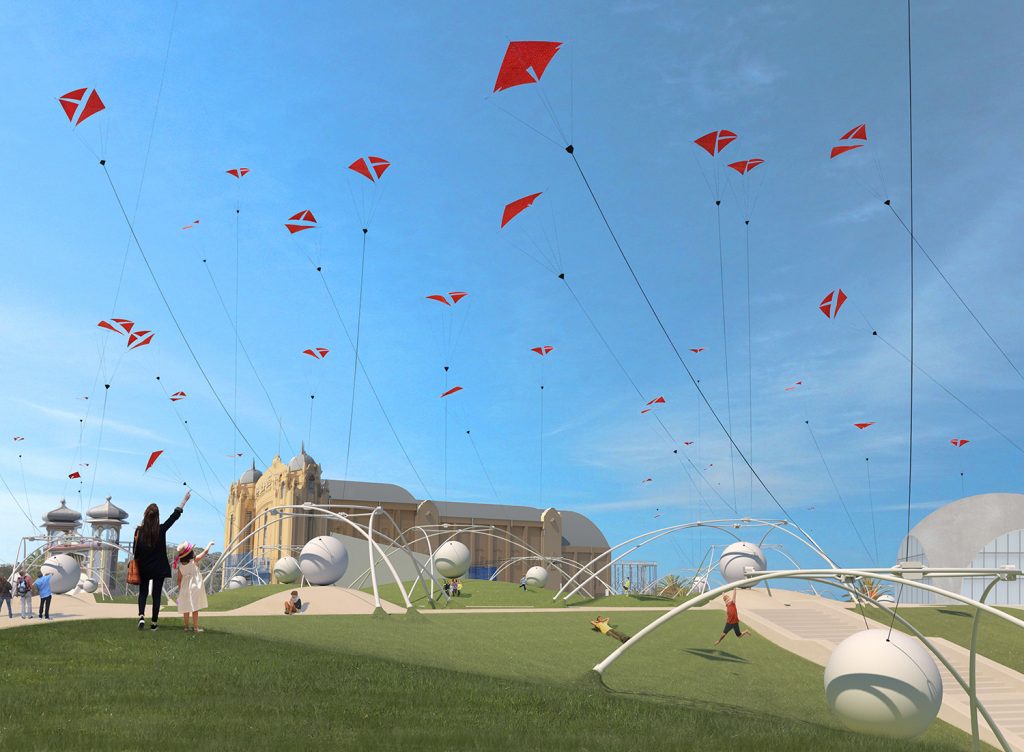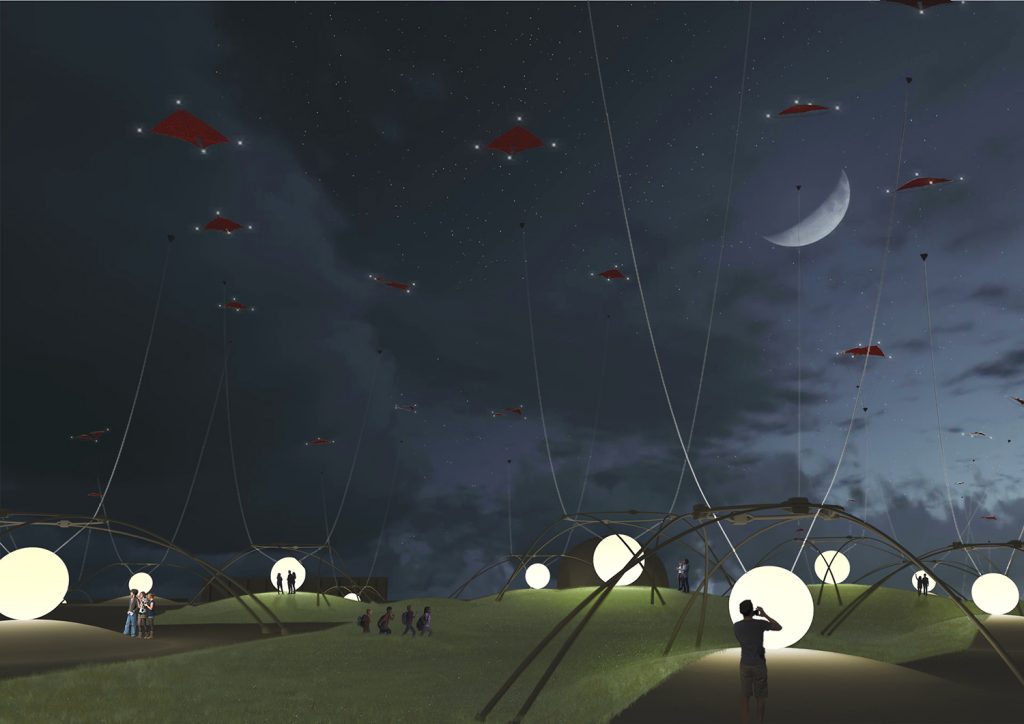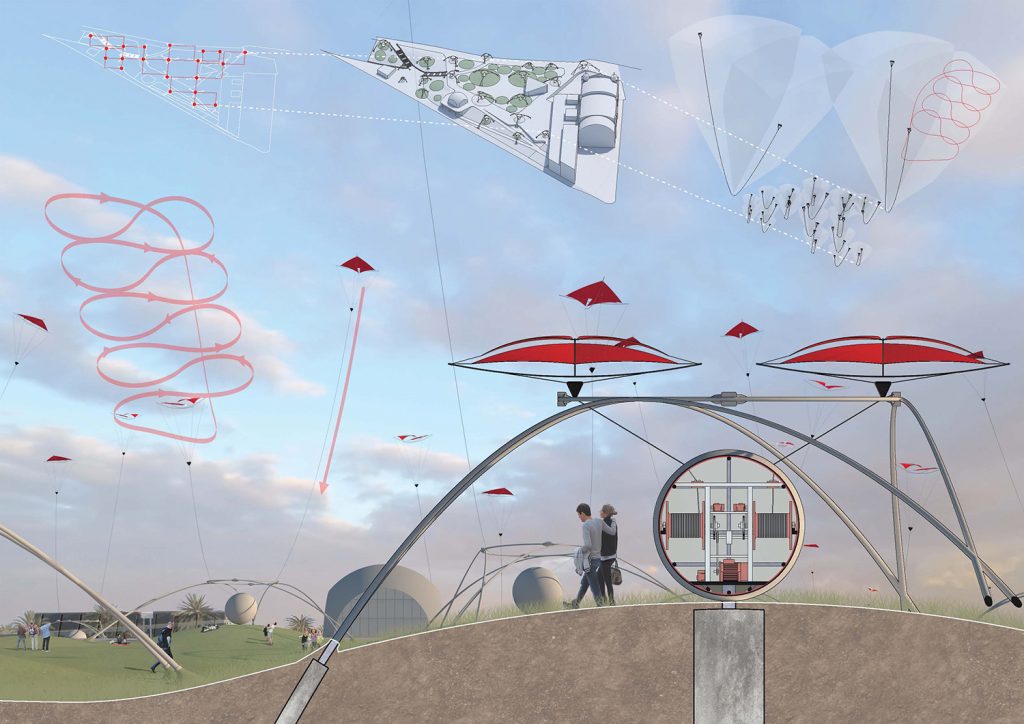
Artist Team: David Donley, Michael Cinalli
Energy Technologies: high altitude wind turbine
(kite HAWT)
Annual Capacity: 1,900 MWh
A submission to the 2018 Land Art Generator design competition for Melbourne.
A pair of architecture students designed a unique work of public art that uses kite power to harvest wind energy for St Kilda Triangle in the City of Port Phillip, Australia.
Yet another design from Eric Oskey’s class at Temple University’s Tyler School of Art, UNWIND takes its inspiration from water sports that are popular in Melbourne. Using the same wind-resistant material deployed in kitesurfing rigs to harvest energy with dozens of high-flying kites, David Donley and Michael Cinalli say their shortlisted proposal for the 2018 Land Art Generator Design competition was specifically designed to feel playful. Controlled by spherical generators safely placed on the ground—one for every two kites—the 42 kites are capable of producing 1,900 MWh each year.
Donley researched a variety of wind energy technologies before settling on what he and Cinalli say is one of the most efficient: kite power. The late ESA astronaut Wubbo Ockels first initiated research in Airborne Wind Energy at Delft University of Technology back in 1996. According to a 2015 article in Renewable and Sustainable Energy Reviews, in 2006 Ockels created a dedicated research group at the university to advance kite power technology to the point of developing a prototype.

Artist Team: David Donley, Michael Cinalli
Energy Technologies: high altitude wind turbine
(kite HAWT)
Annual Capacity: 1,900 MWh
A submission to the 2018 Land Art Generator design competition for Melbourne.
Their research was so successful that Johannes Peschel and Roland Schmehl from TU Delft founded the company Kitepower in 2016 to commercialize the technology. Just last month, they demonstrated for the first time a kite that is capable of producing 100 kilowatts of clean energy.
The company says kite power is twice as efficient as existing wind energy technology (such as turbines), because they can reach higher atmospheric winds that are both more consistent and more powerful than winds closer to the ground. Plus, they have the added benefit of using 90% less material. All of this results in a technology that is easily deployed with minimal environmental impact and at lower cost. Now, a variety of companies are developing Airborne Wind Energy Systems, laying fertile ground for a cutting-edge land art generator design.
With their artwork, the 22-year-old architecture graduates sought to create something that would “breach the status quo” and “turn the mundane into the exciting.” They call it “youthful energy.” At the same time, their installation needed to be appealing for visitors to St Kilda—both day and night. The team explains how it works in their artist’s narrative:
Each unit in UNWIND operates on a system of two kites that cycle in a yo-yo style. While one kite flies up in a figure eight pattern, the second kite is retracted back in. Once the first kite reaches its max height and is positioned to be retracted, the second kite begins its ascent. Inside the spheres are two spools connected to ratcheted gears. The ratcheted gears engage the momentum flywheel when in the traction phase. The momentum flywheel regulates the sporadic speed of the unspooling kites into a consistent output speed. This output rotational energy is connected to the generator that produces the electricity. A small motor is connected to both spools to retract the kites. Each Kite has a KCU (kite control unit) which houses GPS monitors and servo motors attached to the bridles of the kites. The KCU can communicate to the sphere and its partner kite its position through GPS. This positional information is used to direct the kite through its figure eight pattern.

Artist Team: David Donley, Michael Cinalli
Energy Technologies: high altitude wind turbine
(kite HAWT)
Annual Capacity: 1,900 MWh
A submission to the 2018 Land Art Generator design competition for Melbourne.
Engaged in this energy-generating swan dance throughout the day, the kites are bound to draw in visitors to the site. But at night, they create an entirely different spectacle that can be customized according to whatever public activities the City of Port Phillip might have planned. Placed underneath each sphere’s translucent fiberglass shell is an LED mesh that can be programmed to glow in different hues or to produce images or text, perhaps displaying the weather or time of day. In addition to enlivening the landscape with giant balls of color, UNWIND allows guests to directly experience how the kites produce the energy required to run these interactive displays.
And speaking of weather, the proposal incorporates various strategies for mitigating harm in the event that wind gusts are too powerful even for these kites. Not only are the kites fully retractable, but they could be made — as an example — with Challenge Sailcloth’s DLE material comprised of ultra high tenacity yarns with an increased thread count that maintain their strength and form in strong wind loads. The installation includes five different sizes of spheres, frames and kites with varying outputs and reaching varying heights — up to 450 meters.
LAGI co-founders Elizabeth Monoian and Robert Ferry say they love the design’s playfulness, adding that it responds well to the non-profit’s overall mission of getting more people interested in clean energy in a way that will inspire them to take action.
Who wouldn’t want to take a break, lie down on the St Kilda Triangle lawn and watch as the kites meander their way across the sky, zip down to earth, and zoom out to touch the clouds again? UNWIND is incredibly engaging, allowing park-goers to see in real time the energy that results from this daily acrobatics display.
Working on their LAGI design opened the duo to a “new light,” says Cinalli.
“The energy we’re using now is destroying the Earth. We need to become self-sufficient, so incorporating this renewable energy everywhere…functional things, non functional things can help eliminate the need for finite resources.”
As for the students? They are both entering masters programs in architecture—Donley is staying in Philadelphia and Cinalli just moved to Blacksburg, Virginia to attend Virginia Tech. Neither is certain which direction they pursue in the field, but both seem fairly certain their experience with LAGI will influence their future designs.
Tafline Laylin is a freelance communicator and journalist who strives for global environmental and social justice. Her work has appeared in The Guardian, The Atlantic, OZY.com, and a variety of other international publications.
these students from Australia are really good, they are using some ancient technique. however, how do GPS record and monitor kites activity, is still not understood? I think they should join a research institute in Kansas as they have similar projects there